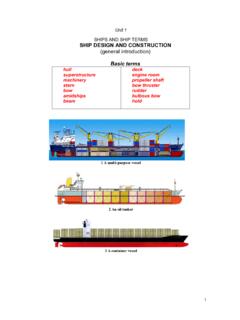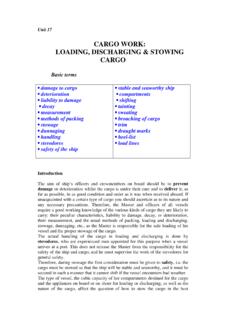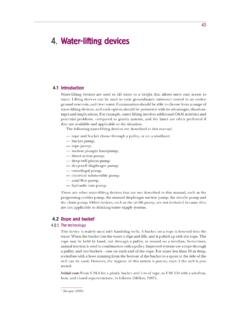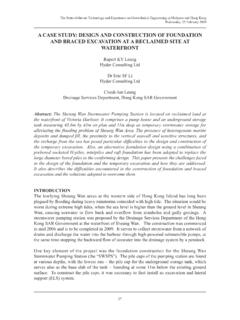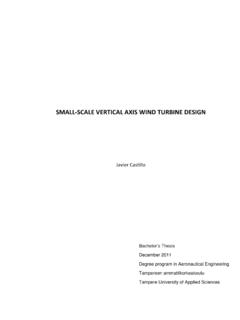Transcription of CARGO-HANDLING EQUIPMENT ON BOARD AND IN PORT - …
1 Unit 16 CARGO-HANDLING EQUIPMENT ON BOARD AND IN PORT Basic terms CARGO-HANDLING EQUIPMENT cargo gear handling facilities lifting gear conveyor belt elevator pumping EQUIPMENT derrick fork lift truck mobile crane straddle carrier tractor tug-master front/side loader van carrier transtainer container crane / portainer transit shed warehouse cranes: dockside crane, quay crane, container crane gantry crane, deck crane (ship s) cargo gear The form of CARGO-HANDLING EQUIPMENT employed is basically determined by the nature of the actual cargo and the type of packing used.
2 The subject of handling facilities raises the important question of mechanization. BULK CARGO HANDLING EQUIPMENT So far as dry bulk cargoes are concerned, handling facilities may be in the form of power-propelled conveyor belts, usually fed at the landward end by a hopper (a very large container on legs) or grabs, which may be magnetic for handling ores, fixed to a high capacity travel1ing crane or travel1ing gantries. These gantries move not only parallel to the quay, but also run back for considerable distances, and so cover a large stacking area, and are able to plumb the ship's hold.
3 These two types of EQUIPMENT are suitable for handling coal and ores. In the case of bulk sugar or when the grab is also used, the sugar would be discharged into a hopper, feeding by gravity a railway wagon or road vehicle below. Elevators (US) or silos are normally associated with grain. They may be operated by pneumatic suction which sucks the grain out of the ship's hold. SHIP UNLOADERS FRONT LOADER BELT CONVEYOR HOPPER HOPPER SILO / ELEVATOR GRAB TYPE UNLOADERS LOADING BOOM LIQUID CARGO HANDLING EQUIPMENT The movement of liquid bulk cargo, crude oil and derivatives, from the tanker is undertaken by means of pipelines connected to the shore-based storage tanks.
4 pumping EQUIPMENT is provided in the tanker storage plant or refinery ashore, but not on the quayside. In view of the dangerous nature of such cargo, it is common practice to build the special berths a small distance from the main dock system on the seaward side. Oil cargo is discharged from the ship s tanks, via the cargo piping system to the main ship s manifold usually situated amidships, on either port or starboard side. From there by means of shore-based loading arms oil is transferred to the shore manifold and is then distributed to shore-based storage tanks on the oil terminal.
5 The loading arm hose must be flanged oil-tight to the ship s manifold so that oil spills can be avoided. TERMINAL MANIFOLD SHIP S MANIFOLD LOADING ARMS GENERAL CARGO HANDLING EQUIPMENT With regard to general cargo (goods, merchandise, commodities), also referred to as break bulk cargo, almost 90 percent of all such cargo in most liner cargo trades today is containerized. Meanwhile the system of dockers handling cargo will continue, but doubtless every effort will be made to expand the a1ready extensive use of various types of mechanized cargo-hand1ing EQUIPMENT .
6 General cargo is handled by cranes on the quay, floating cranes or by the ship's own cargo gear (deck cranes, derricks, etc.). Attached to such lifting gear is a shackle which links the crane or derrick with the form of CARGO-HANDLING EQUIPMENT being used. For most lifts a hook is used. There are numerous types of tools or loose gear that can be attached to the shipboard or shore-based lifting gear. They include the sling or strop, which is probably the most common form of loose gear.
7 Such EQUIPMENT , generally made of rope, is ideal for hoisting strong packages, such as wooden cases or bagged cargo, which is not likely to sag or be damaged when raised. Similarly, snotters or canvas slings are suitable for bagged cargo. Chain slings, however, are used for heavy slender cargoes, such as timber or steel rails. Can or barrel hooks are suitable for hoisting barrels or drums. Cargo nets are suitable for mail bags and similar cargoes that are not liable to be crushed when hoisted.
8 Heavy lifting beams are suitable for heavy and long articles such as locomotives, boilers or railway passenger coaches. Cargo trays and pallets, the latter being wooden or of steel construction, are ideal for cargo of moderate dimensions, which can be conveniently stacked, such as cartons, bags, or small wooden crates or cases. CONTAINER FITTINGS CHAIN SLING TWISTLOCK CONTAINER FITTINGS AND LASHING CORNER CASTING CARGO NET HOOKS LIFTING BEAM Cargo Handling EQUIPMENT or Lifting Gear (loose gear & cargo tools)
9 TYPES OF PACKING AND LIFTING EQUIPMENT /GEAR WIRE SLING DRUM/BARREL KEG CASKS CARGO HOOKS CRATES BOX / CASE CARGO SLINGS BOX HOOK PLATE CLAMP PALLET LIFTING GEAR MODERN CARGO HANDLING BLOCK AND TACKLE SYSTEMS TACKLE: BLOCK AND SHEAVE TACKLE LIFTING GEAR Additionally, dog or case hooks and case and plate clamps are suitable for transhipping cargo to railway wagons or road vehicles, but not to or from the ship, except to facilitate trans-shipping the cargo in the hold to enable suitable CARGO-HANDLING gear to be attached.
10 Plate clamps are used for lifting metal plates. Dockers working in the ship's holds also use pinch or crowbars for moving heavy packages, and band books for manoeuvring packages into position. PORT/TERMINAL CARGO HANDLING EQUIPMENT A lot of terminal or port cargo handling EQUIPMENT is provided to facilitate movement of the cargo to and from the ship's side and the transit shed, warehouse, barge, railway wagon or road vehicle. These include two-wheeled hand barrows and four-wheeled trucks either manually or mechanica1ly propelled, and mechanically or electrica1ly propelled tractors for hauling four-wheeled trailers.




